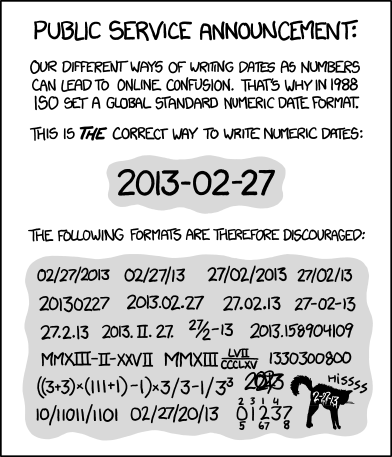2013-02-27, Indeed!
Okay, I just have to say, Amen, XKCD and ISO!
If you are naming files on a computer, please use this format. The beauty is that if you list files in “alphabetical order” then these dates get listed in chronological order, because as far as a computer is concerned, the “0” comes before “1” and so forth. (And a year is more significant than a month is more significant than a day of the month . . .)
It is important to have that leading zero! Why? Because we have more than 10 months! Allow me to demonstrate:
0-11:32 djh@noneedto ~$ (echo "2013-02-27" && echo "2013-12-27") | sort 2013-02-27 2013-12-27 0-11:32 djh@noneedto ~$ (echo "2013-2-27" && echo "2013-12-27") | sort 2013-12-27 2013-2-27
If you are interacting with strftime() then what you want to remember is %F!
0-11:38 djh@noneedto ~$ date +%Y-%m-%d 2013-02-27 0-11:38 djh@noneedto ~$ date +%F 2013-02-27 0-11:38 djh@noneedto ~$ date +%Y%m%d%H%M # I sometimes use this for file timestamps but dont tell Randall Monroe 201302271138
For my photographs, I have a directory hierarchy of %Y/%m-%B:
0-11:43 djh@noneedto Photographs$ find . -type d | sort | tail ./2012/08-August/Costa_Rica/Santa_Teresa ./2012/08-August/Costa_Rica/Ziplines ./2012/09-September ./2012/09-September/Sonogram ./2012/10-October ./2012/11-November ./2012/12-December ./2013 ./2013/01-January ./2013/02-February
This gives me the human convenience of seeing the month name on my folders, but the computer sorts those folders in chronological order.


Comment
Tiny Print:
<a href="" title=""> <abbr title=""> <acronym title=""> <b> <blockquote cite=""> <cite> <code> <del datetime=""> <em> <i> <q cite=""> <s> <strike> <strong>